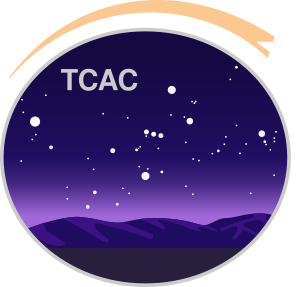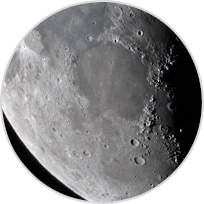
|
Tri-City Astronomy Club
|

The general public is welcome to come to all the star parties listed our home page. Our members are passionate about sharing their knowledge, and believe that everyone should get to see the rest of the universe with their own eyes. So, come look through large telescopes, and get your questions about astronomy answered. Views are free of charge. (We do have expenses though, so donations are gratefully accepted!) If you have your own telescope, you can bring it and get tips on how to use it to its full potential. There are two very different categories of star parties, so read on!
At one of these events, all the telescopes are going to be pointed at the same half dozen objects. There is a good reason for this: The light of the city brightens the sky and blots out the nebulae, star clusters, and galaxies. There are only a couple things bright enough to punch through. The moon and planets all can, so that's what we focus on. We usually plan these events when the moon is well-placed so you can observe its craters, mountains, and dark lava flows.
Jupiter and Saturn, the two largest and most interesting planets, are each visible for about half of the year. Mars is close enough to be visible for around three months every two and a half years or so. Any astronomy program and many web pages will show you when they are up. If they are low on the horizon, they will be obscured by dust and turbulence in the atmosphere, but they will be visible. Unless the air is particularly bad, you should be able to see three or four moons of Jupiter, the rings of Saturn, and one of the icy poles of Mars.
If you arrive after dark, please be careful with your car's lights to help us preserve our night vision. If you see any telescopes in your headlights, you have already blinded everyone. If you can do it safely, pull in to the parking lot with just your parking lights on. Then come find us on foot.
We love to see children at our star parties, but please make sure they are well supervised and not on their own. We will have tripods, cords, and boxes of equipment on the ground, and we don't want anyone hurt. Like you, we love our pets, but please leave them at home this time.

These are the events to come to if you want to see nebulae and galaxies! But, to see these faint objects, you need your eyes to fully adapt to the dark. It takes about half an hour for that to happen, and just a second to lose it all if a light shines at you.
Because of this, we are very strict about lights. Even a small flashlight is enough to ruin someone's night, and car lights would ruin everybody's night.
First of all, only red lights are allowed, because they are less damaging to your night vision than white lights. Bring a dim red flashlight to find your way around. You can order a flashlight made for astronomy, but the easiest way to get one is just to put red duct tape over the end of a normal flashlight. It may seem too dim to be useful during the day, but you will be surprised at how bright it will seem when your eyes have adapted to the dark. You can also put a few layers of red paper or tape under the plastic lens for a nicer-looking solution. Clear red filters let too much light through, so don't use them. And, even if your phone has a night mode, it is also far too bright for these dark locations.

Second, be careful with your car. If you might want to get into your car during the night, you need to make sure all the interior lights are turned off before it gets dark. Also make sure it won't flash it's parking lights when it is unlocked or opened. If you are parked in view of the telescopes, and you can't avoid doing anything that would cause it to flash, you will probably have to take out the fuse. If you might leave before the star party is over, park well away from it and facing out. Your tail lights will tough for everyone to deal with, but your backup lights would be much worse.
It is very hard to arrive after dark without making everyone unhappy, so we strongly recommended against it.